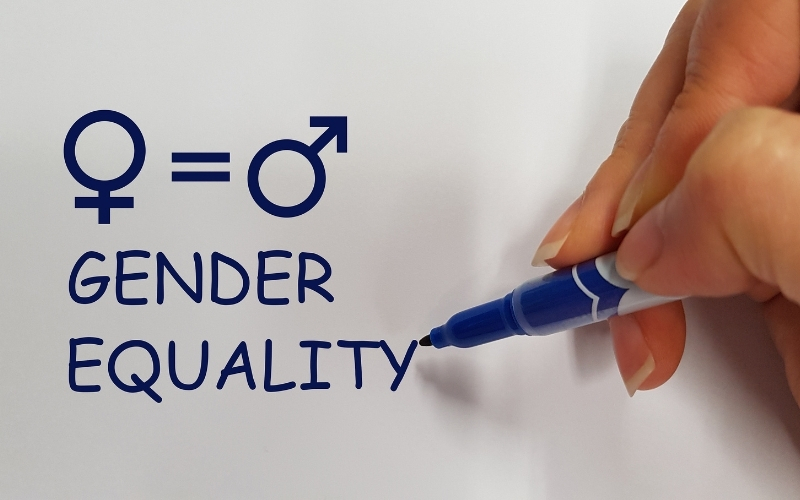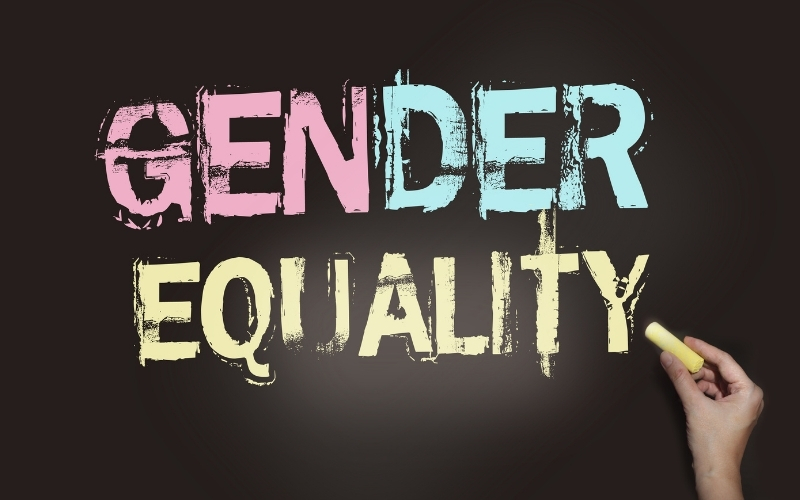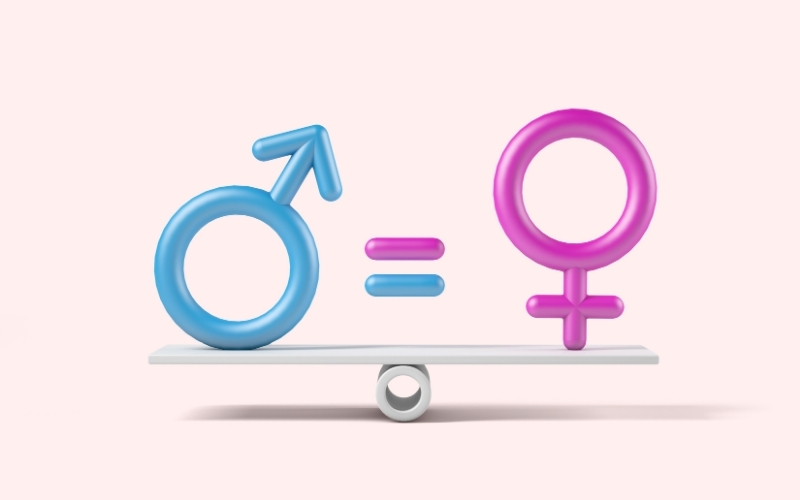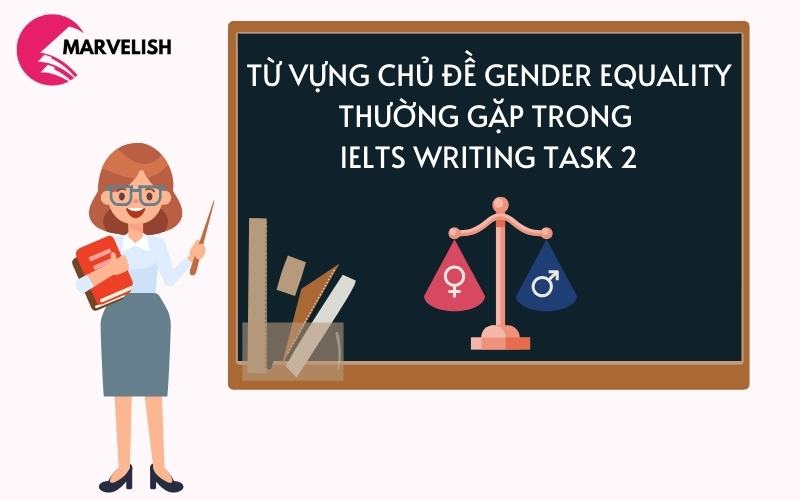Gender Equality (Bình đẳng giới) là một trong những chủ đề quan trọng và thường xuất hiện trong phần thi IELTS Writing Task 2. Không chỉ vì tính thời sự và ý nghĩa xã hội sâu sắc, mà còn bởi nó đòi hỏi thí sinh phải có kiến thức vững vàng và khả năng diễn đạt tốt. Trong bài viết này, Marvelish sẽ bật mí bộ từ vựng chủ đề Gender Equality thường gặp, cùng với những ý tưởng hữu ích để giúp bạn hoàn thành bài thi IELTS Writing Task 2 với số điểm cao.
Tổng quan về chủ đề Gender Equality
Chủ đề Gender Equality (Bình đẳng giới) là một trong những chủ đề phổ biến và được ưa chuộng trong phần thi IELTS Writing Task 2. Đây là một chủ đề rộng lớn, bao gồm nhiều khía cạnh khác nhau của cuộc sống như giáo dục, công việc, vai trò trong gia đình và các quyền lợi xã hội. Việc hiểu rõ và nắm vững những khía cạnh này sẽ giúp thí sinh chuẩn bị tốt hơn cho bài thi viết.

Trong IELTS Writing Task 2, các câu hỏi về chủ đề bình đẳng giới thường yêu cầu thí sinh thảo luận về quan điểm, phân tích vấn đề hoặc đề xuất giải pháp. Các dạng câu hỏi phổ biến có thể bao gồm:
- Bàn luận về vai trò của nam giới và nữ giới trong gia đình và xã hội: Ví dụ, bạn có thể được yêu cầu thảo luận về sự phân chia công việc nhà giữa nam và nữ, hay vai trò của phụ nữ trong lực lượng lao động.
- Phân tích tác động của bình đẳng giới trong giáo dục: Bạn có thể cần phân tích cách mà bình đẳng giới ảnh hưởng đến cơ hội giáo dục của cả nam và nữ, và cách mà giáo dục có thể giúp đạt được bình đẳng giới.
- Đề xuất giải pháp để đạt được bình đẳng giới trong công việc: Các câu hỏi có thể yêu cầu bạn đề xuất các biện pháp để đảm bảo rằng cả nam và nữ đều có cơ hội bình đẳng trong việc thăng tiến nghề nghiệp và nhận lương.
Bên cạnh việc hiểu rõ nội dung, thí sinh cũng cần phải biết sử dụng các từ vựng chủ đề Gender Equality chuyên ngành và các cấu trúc ngữ pháp phù hợp để thể hiện ý kiến một cách rõ ràng và thuyết phục. Việc chuẩn bị kỹ càng cho chủ đề này không chỉ giúp bạn tự tin hơn khi bước vào phòng thi, mà còn giúp bạn có khả năng viết các bài luận logic và mạch lạc hơn.
Xem thêm: 16 Cách Học Từ Vựng Tiếng Anh Nhớ Lâu Hiệu Quả, Không Bao Giờ Quên
Một số dạng đề thường gặp về topic Gender Equality
Chủ đề Gender Equality được đánh giá là một chủ đề khó, do đó người học nên trang bị đầy đủ vốn từ vựng chủ đề Gender Equality để có thể làm bài tốt hơn. Dưới đây là một số đề bài thường gặp thuộc chủ đề bình đẳng giới:
- Some people think that men and women have different qualities. Therefore, some certain jobs are suitable for men and some jobs are suitable for women. To what extent do you agree or disagree?
- In some countries, people think women should have equality with men, in particular, equal rights to work as police officers or serve in the Army. Others think women are not suitable for such jobs. Discuss both views and give your own opinion.
- Most high-level positions in companies are filled by men even though the workforce in many developed countries is more than 50 percent female. Companies should be required to allocate a certain percentage of these positions to women. To what extent do you agree or disagree?
- Some people believe that in present times, women do get as much equality at work as men, while others believe that even today women have to fight their way to succeed at work. Discuss both views and give your opinion.
- Women and men are commonly seen as having different strengths and weaknesses. Is it right to exclude males or females from certain professions because of their gender?
- Many people think that men should go out to work while women’s place is in the home. To what extent do you agree or disagree?
- Many people believe that women make better parents than men and that this is why they have the greater role in raising children in most societies. Others claim that men are just as good as women at parenting. Write an essay expressing your point of view. Give reasons for your answer.
- In spite of many advances women have made in education and employment, they continue to be at a disadvantage when it comes to pay and promotion. In your view, what should be done to promote equality of opportunity for men and women in the workplace?
- Universities should accept equal numbers of male and female students in every subject. To what extent do you agree or disagree?

Xem thêm: Top 7 App Luyện Writing IELTS Hiệu Quả, Chất Lượng Tốt Nhất Hiện Nay
Bộ từ vựng chủ đề Gender Equality thông dụng trong IELTS Writing Task 2
Trong IELTS Writing Task 2, chủ đề Gender Equality (Bình đẳng giới) thường xuyên xuất hiện, yêu cầu thí sinh không chỉ có kiến thức sâu rộng mà còn cần vốn từ vựng phong phú và chính xác. Việc nắm vững và sử dụng chính xác từ vựng liên quan sẽ giúp bạn diễn đạt ý tưởng một cách rõ ràng, logic và thuyết phục hơn. Dưới đây là bộ từ vựng chủ đề Gender Equality mà bạn nên biết để tự tin viết về chủ đề này:
|
Từ vựng |
Phiên âm | Từ loại | Dịch nghĩa |
Ví dụ |
| equality | /ɪˈkwɒləti/ | noun | sự bình đẳng | Gender equality is essential for a fair society. |
| discriminate | /dɪˈskrɪmɪneɪt/ | verb | sự phân biệt đối xử | It’s illegal to discriminate against someone based on gender. |
| male-dominated | /meɪlˈdɒmɪneɪtɪd/ | adjective | hầu hết là đàn ông | The tech industry is often male-dominated. |
| female-dominate | /ˈfiːmeɪlˈdɒmɪneɪtɪd/ | adjective | hầu hết là phụ nữ | Nursing is traditionally female-dominated. |
| glass ceiling | /ˈɡlɑːs ˈsiːlɪŋ/ | noun | rào cản vô hình | Many women face the glass ceiling in corporate environments. |
| stereotype | /ˈsteriətaɪp/ | noun | thành kiến | Gender stereotypes can limit individual potential. |
| breadwinner | /ˈbredˌwɪnər/ | noun | trụ cột gia đình | Traditionally, men were seen as the breadwinners of the family. |
| social bias | /ˈsəʊʃəl baɪəs/ | noun | định kiến xã hội | Social bias can influence hiring decisions. |
| patriarchal ideology | /ˌpeɪtriˈɑːkəl aɪdɪˈɒlədʒi/ | noun | tư tưởng gia trưởng | Some societies still uphold patriarchal ideologies. |
| share responsibility | /ʃeə rɪˌspɒnsəˈbɪlɪti/ | verb | chia sẻ trách nhiệm | Couples should share responsibility for household chores. |
| feminine character | /ˈfemənɪn ˈkærəktə(r)/ | noun | tính nữ | She has a strong feminine character that inspires others. |
| impose backward ideas on women | /ɪmˈpəʊz ˈbækwəd aɪˈdɪəz ɒn ˈwɪmɪn/ | verb | áp đặt quan điểm bảo thủ với phụ nữ | Society should not impose backward ideas on women’s roles. |
| domestic violence | /dəˈmestɪk ˈvaɪələns/ | noun | bạo lực trong gia đình | Domestic violence affects many families worldwide. |
| to dismiss gender misconception | /tuː dɪsˈmɪs ˈdʒendə mɪsˈkɒnsepʃn/ | verb | loại bỏ hiểu lầm về giới tính | Education is key to dismissing gender misconceptions. |
| the promotion of gender equality | /ðə prəˈməʊʃn ʌv ˈdʒendər ɪˈkwɒləti/ | noun | thúc đẩy bình đẳng giới | Governments play a crucial role in the promotion of gender equality. |
| the prevention of discrimination | /ðə prɪˈvenʃn ʌv dɪˌskrɪmɪˈneɪʃn/ | noun | ngăn chặn phân biệt đối xử | Laws are in place for the prevention of discrimination. |
| the promotion of sympathy and understanding | /ðə prəˈməʊʃn ʌv ˈsɪmpəθi ænd ˌʌndərˈstændɪŋ/ | noun | tăng cường sự cảm thông và thấu hiểu | Media can contribute to the promotion of sympathy and understanding. |
| favoritism | /ˈfeɪvərɪtɪzəm/ | noun | sự thiên vị | There were accusations of favoritism in the hiring process. |
| preconceived societal notions | /ˌpriːkənˈsiːvd səˈsaɪətl ˈnəʊʃnz/ | noun | các định kiến có trước của xã hội | Overcoming preconceived societal notions is challenging. |
| equal distribution | /ˈiːkwəl ˌdɪstrɪˈbjuːʃn/ | noun | phân bổ bằng nhau | Fair taxation ensures equal distribution of resources. |
| gender-specific characteristics and competence | /ˈdʒendə ˌspɪˈsɪfɪk ˌkærəktəˈrɪstɪks ænd ˈkɒmpɪtəns/ | noun | đặc điểm cụ thể về giới tính và năng lực | Recognizing gender-specific characteristics is important in education. |
| the weaker sex | /ðə ˈwiːkər seks/ | phrase | thường chỉ phái nữ – chân yếu tay mềm | Referring to women as the weaker sex is outdated. |
| the gender gap/ the gender imbalance/ gender segregation | /ðə ˈdʒendə gæp/ ðə ˈdʒendər ɪmˈbæləns/ ˈdʒendər ˌseɡrɪˈɡeɪʃn/ | phrase | chênh lệch giới tính | Closing the gender gap in pay is a global challenge. |
| underrepresentation | /ˌʌndərˌreprɪzenˈteɪʃn/ | noun | sự thiếu số/ chiếm tỉ lệ nhỏ trong số đông | There is underrepresentation of women in leadership roles. |
| gender-segregated sectors | /ˈdʒendə ˈseɡrɪˌɡeɪtɪd ˈsektə(r)z/ | phrase | các ngành có tính phân biệt giới | Engineering and nursing are often gender-segregated sectors. |
| gender-neutral | /ˈdʒendə ˈnjuːtrəl/ | adjective | trung lập về giới tính | The new policy aims to create a gender-neutral environment. |
| the gender gap in pay | /ðə ˈdʒendə gæp ɪn peɪ/ | phrase | khoảng cách giới về lương | The gender gap in pay persists despite efforts to address it. |
| look down on | /lʊk daʊn ɒn/ | phrasal verb | coi thường | It’s wrong to look down on people based on their gender. |
| feudalistic society | /fjuːˈdəlɪstɪk səˈsaɪəti/ | noun | xã hội phong kiến | Feudalistic societies often have strict gender roles. |
| enfranchise women | /ɪnˈfræntʃaɪz ˈwɪmɪn/ | verb | cho phụ nữ quyền bầu cử | The suffragette movement aimed to enfranchise women. |
| child-rearing | /tʃaɪld ˈrɪərɪŋ/ | noun | nuôi dưỡng con | Child-rearing should be a shared responsibility. |
| child-bearing | /tʃaɪld ˈbeərɪŋ/ | noun | sinh con | Policies to support child-bearing families are important. |
| bring up children | /brɪŋ ʌp ˈtʃɪldrən/ | phrasal verb | nuôi dưỡng con cái | It’s challenging to bring up children in today’s society. |
| economic foundation | /ˌiːkəˈnɒmɪk faʊnˈdeɪʃn/ | noun | nền tảng tài chính | Education is the economic foundation of any society. |
| single-mother families | /ˈsɪŋɡəl-ˈmʌðə(r) ˈfæmɪliz/ | noun | gia đình một mẹ | Policies to support single-mother families are crucial. |
| pursue higher education | /pəˈsjuː ˈhaɪər ˌɛdʒʊˈkeɪʃn/ | verb phrase | theo đuổi học cao | Many women pursue higher education to advance their careers. |
| hold high positions | /həʊld haɪ pəˈzɪʃnz/ | verb phrase | giữ vị trí cao | Women are increasingly holding high positions in companies. |
| unwanted pregnancy | /ˌʌnˈwɒntɪd ˈpreɡnənsi/ | noun | có thai ngoài ý muốn | Access to contraception reduces unwanted pregnancies. |
| shoulder family responsibilities | /ˈʃəʊldə(r) ˈfæmɪli rɪˌspɒnsəˈbɪlɪtiz/ | verb phrase | gánh vác trách nhiệm gia đình | Both parents should shoulder family responsibilities equally. |
| shun away family responsibilities | /ʃʌn əˈweɪ ˈfæmɪli rɪˌspɒnsəˈbɪlɪtiz/ | verb phrase | tránh trách nhiệm gia đình | It’s unfair to shun away family responsibilities. |
| self-reliant | /ˌself rɪˈlaɪənt/ | adjective | tự lập | She became self-reliant after going through tough times. |
| ambitious | /æmˈbɪʃəs/ | adjective | tham vọng | She is ambitious and aims to succeed in her career. |
Xem thêm: Mới Bắt Đầu Học IELTS Nên Học Kỹ Năng Nào Trước?
Những ideas về chủ đề Gender Equality mà bạn nên học
Bên cạnh bộ từ vựng chủ đề Gender Equality, việc có sẵn những ý tưởng đa dạng và sâu sắc về chủ đề này sẽ giúp bạn viết bài mạch lạc và thuyết phục hơn trong IELTS Writing Task 2. Hiểu rõ các khía cạnh khác nhau của chủ đề này không chỉ giúp bạn trả lời tốt các câu hỏi mà còn thể hiện khả năng tư duy và lập luận của mình. Dưới đây là những ý tưởng về chủ đề Gender Equality mà bạn nên học để chuẩn bị tốt hơn cho kỳ thi IELTS:
Gender and Education (Giới tính và giáo dục)
- Men and women should have access to the same educational opportunities.
- Males and females should be accepted onto courses according to their abilities.
- It is wrong to discriminate against students because of their gender.
- Gender should be irrelevant in education.
- Student’s achievements should depend on hard work and individual merit.
- In the UK, there are similar numbers of male and female students in higher education.

Gender and Work (Giới tính và công việc)
- Men and women should have access to the same professional opportunities.
- Both men and women should be able to pursue a career.
- They should earn equal salaries.
- They should be employed according to their abilities, qualifications and experience.
- Traditionally women have been restricted to certain roles.
- They were often employed as secretaries or receptionists.
- Nowadays, a range of occupations is available to both sexes.
- Career success depends on individual merit.

Women’s and Men’s Roles in the Family (Vai trò của nam và nữ trong gia đình)
- Some people argue that a mother should not work.
- She should stay at home and bring up her children.
- The father should be the breadwinner of the family.
- Others believe that both parents should share these responsibilities.
- Working women can take maternity leave during and after pregnancy.
- Many mothers continue to work after this period.
- Many fathers and mothers share their parenting and domestic responsibilities.
- They contribute equally to childcare, cooking and cleaning.
- Some women may have better career prospects than their husbands.
- Paternity leave and ‘househusbands’ are becoming more common.
- Traditional gender roles are gradually changing.
- Families can divide roles and responsibilities in the most convenient way.

Xem thêm: Review Sách Hackers IELTS Trọn Bộ Chi Tiết Từ A-Z Và Link Download PDF Miễn Phí
Bài tập vận dụng từ vựng IELTS chủ đề Gender Equality
Việc nắm vững từ vựng chủ đề Gender Equality không chỉ quan trọng để vượt qua các kỳ thi tiếng Anh như IELTS mà còn để hiểu và tham gia vào các cuộc thảo luận xã hội quan trọng. Sau đây là một số bài tập vận dụng từ vựng chủ đề Gender Equality, giúp bạn rèn luyện kỹ năng sử dụng từ vựng một cách chính xác và hiểu sâu hơn về những vấn đề quan trọng liên quan đến bình đẳng giới. Việc áp dụng các thuật ngữ và cụm từ phù hợp sẽ giúp bài viết của bạn trở nên thuyết phục và chặt chẽ hơn, phản ánh được quan điểm của bạn về vấn đề này một cách sắc nét.

Bài tập
Bài tập 1: Chọn câu trả lời đúng
- Gender equality is about ensuring:
- a) Fair treatment for all individuals regardless of their gender identity.
- b) Preferential treatment for women over men.
- c) Discrimination against men.
- d) None of the above.
- The term “glass ceiling” refers to:
- a) Invisible barriers that prevent women from reaching top leadership positions.
- b) The clear distinction between men’s and women’s roles in society.
- c) Gender-specific stereotypes in education.
- d) Equal pay for equal work.
- Patriarchal ideologies often emphasize:
- a) Equal rights for men and women.
- b) Male dominance in decision-making.
- c) Gender-neutral policies.
- d) None of the above.
- Achieving gender equality requires addressing:
- a) Stereotypes and biases.
- b) Cultural diversity.
- c) Economic development.
- d) All of the above.
- Which of the following is NOT a barrier to gender equality?
- a) Glass ceiling.
- b) Equal pay gap.
- c) Promotion of gender equality.
- d) Social bias.
- Gender equality aims to achieve ___________ treatment for individuals of all genders.
- a) Equal
- b) Preferential
- c) Discriminatory
- d) Selective
- The concept of the “glass ceiling” refers to:
- a) Barriers preventing women from advancing to top positions.
- b) Transparent workplace policies.
- c) Equal pay for equal work.
- d) Gender-specific job roles.
- Patriarchal ideologies often emphasize:
- a) Equal opportunities for all genders.
- b) Male dominance in societal roles.
- c) Gender-neutral policies.
- d) Workplace diversity.
- Promoting gender equality involves challenging:
- a) Cultural diversity.
- b) Gender stereotypes and biases.
- c) Economic policies.
- d) Educational standards.
- The term “gender gap” refers to:
- a) Equal distribution of resources between genders.
- b) Differences in pay and opportunities between genders.
- c) Social biases against men.
- d) Employment quotas for women.
- A key barrier to gender equality in the workplace is the:
- a) Glass ceiling.
- b) Promotion of diversity.
- c) Equal pay policies.
- d) Family responsibilities.
- Equal pay for equal work is a fundamental aspect of:
- a) Gender discrimination.
- b) Gender equality.
- c) Stereotyping.
- d) Gender roles.
- Governments play a crucial role in enforcing laws against:
- a) Gender stereotypes.
- b) Discrimination.
- c) Gender-neutral policies.
- d) Cultural practices.
- Addressing ___________ involves changing societal beliefs and attitudes toward gender roles.
- a) Gender equality
- b) Glass ceiling
- c) Patriarchal ideologies
- d) Discrimination
- The term “stereotype” refers to:
- a) Fixed and oversimplified ideas about individuals based on their gender.
- b) Workplace diversity initiatives.
- c) Legal protections against discrimination.
- d) Equal opportunities in education.
- Achieving gender equality requires promoting:
- a) Cultural diversity.
- b) Social biases.
- c) Inclusive policies and practices.
- d) Gender-specific job roles.
- One aspect of gender equality is the promotion of:
- a) Stereotypes.
- b) Biases.
- c) Discrimination.
- d) Sympathy and understanding.
- The term “patriarchal ideologies” refers to beliefs that emphasize:
- a) Equal rights for all genders.
- b) Male dominance and authority.
- c) Workplace diversity.
- d) Gender-neutral policies.
- Closing the ___________ requires addressing disparities in pay and opportunities between genders.
- a) Glass ceiling
- b) Gender gap
- c) Stereotype
- d) Discrimination
- The concept of “equal distribution” involves:
- a) Gender-specific characteristics and competence.
- b) Equal sharing of responsibilities between genders.
- c) Workplace diversity.
- d) Legal protections for women.
- Gender equality initiatives aim to create:
- a) Biases.
- b) Stereotypes.
- c) Favoritism.
- d) Equal opportunities for all individuals.
- The term “social bias” refers to:
- a) Legal protections for gender equality.
- b) Economic foundations.
- c) Preconceived societal notions that favor one gender over another.
- d) Gender-specific roles in family life.
- Achieving gender equality involves challenging:
- a) Glass ceilings.
- b) Equal pay.
- c) Stereotypes and biases.
- d) Workplace diversity.
- Empowering women to pursue higher education and hold high positions promotes:
- a) Child-rearing.
- b) Gender segregation.
- c) Economic foundations.
- d) Gender equality.
- The promotion of gender equality aims to:
- a) Reinforce patriarchal ideologies.
- b) Enfranchise women.
- c) Shun away family responsibilities.
- d) Discriminate against men.
Bài tập 2: Điền từ thích hợp vào chỗ trống để hoàn thành câu văn
- _________ should be encouraged to pursue careers traditionally seen as _________-dominated.
- The media plays a crucial role in promoting _________ and understanding towards diverse _________ roles.
- _________ in the workplace can hinder career advancement and perpetuate _________ stereotypes.
- Governments should enact policies to close the _________ in _________.
- Gender ___________ in the workplace remains a significant issue, with many industries still being ___________-dominated.
- ___________ stereotypes often lead to discrimination and unequal opportunities.
- The concept of a ______________________ suggests that women face invisible barriers to advancing in their careers.
- Governments must promote ___________ of gender roles and enforce laws against ___________ in employment.
- The ______________________ is a common barrier faced by women striving for top executive positions.
- ___________ is crucial for achieving fairness and equality in society.
- Many societies still uphold ______________________ that prioritize male dominance in decision-making.
- Achieving ___________ requires overcoming societal biases and preconceptions.
- ___________ should not limit career opportunities based on gender.
- The media plays a role in promoting ___________ and understanding of diverse gender roles.
- ___________ in pay between genders remains a challenge despite progress in other areas.
- To achieve ___________ in the workplace, companies need to address biases in hiring and promotion.
- ___________ of laws is essential to protect against discrimination in all aspects of life.
- Single-mother families often face challenges due to ______________________ in society.
- Education plays a crucial role in challenging ___________ and promoting gender equality.
- Women continue to face ___________ in male-dominated industries such as technology and engineering.
- Closing the ______________________ requires addressing systemic biases in pay and promotion.
- ___________ responsibilities should be shared equally between partners in a modern family.
- ______________________ in leadership roles can lead to more diverse and innovative decision-making.
- The promotion of ___________ is essential for building a fair and inclusive society.
- Laws against ___________ are necessary to ensure fair treatment in employment and education.
- Achieving ___________ requires addressing unconscious biases in everyday interactions.
- Women’s access to ___________ opportunities should be equal to men’s in all sectors.
- Overcoming ______________________ is crucial for promoting women’s leadership in politics.
- The ______________________ affects women’s advancement in many professions.
- ______________________ in education can lead to more opportunities for women in STEM fields.
- Governments should prioritize policies that promote ___________ of women in decision-making roles.
- Achieving ___________ requires challenging deep-seated beliefs about gender roles.
- Women’s empowerment includes promoting their ___________ in economic and political spheres.
Đáp án
Bài tập 1:
- a) Fair treatment for all individuals regardless of their gender identity.
- a) Invisible barriers that prevent women from reaching top leadership positions.
- b) Male dominance in decision-making.
- a) Stereotypes and biases.
- c) Promotion of gender equality.
- a) Equal
- a) Barriers preventing women from advancing to top positions.
- b) Male dominance in societal roles.
- b) Gender stereotypes and biases.
- b) Differences in pay and opportunities between genders.
- a) Glass ceiling.
- b) Gender equality.
- b) Discrimination.
- c) Patriarchal ideologies.
- a) Fixed and oversimplified ideas about individuals based on their gender.
- c) Inclusive policies and practices.
- d) Sympathy and understanding.
- b) Male dominance and authority.
- b) Gender gap.
- b) Equal sharing of responsibilities between genders.
- d) Equal opportunities for all individuals.
- c) Preconceived societal notions that favor one gender over another.
- c) Stereotypes and biases.
- c) Economic foundations.
- b) Enfranchise women.
Bài tập 2:
- Women, male
- sympathy, gender
- Discrimination, gender
- gender gap, pay
- discrimination, male-dominated
- Gender, stereotypes
- glass ceiling
- equality, discrimination
- glass ceiling
- Equality
- patriarchal ideologies
- equality
- Stereotypes
- sympathy
- Gender gap
- equality
- Enforcement
- patriarchal ideologies
- stereotypes
- discrimination
- gender pay gap
- Family responsibilities
- Gender diversity
- gender equality
- discrimination
- equality
- educational
- patriarchal ideologies
- glass ceiling
- Equal opportunities
- representation
- equality
- participation
Xem thêm: Review Sách Cambridge Grammar For IELTS: Nội Dung, Ưu Nhược Điểm Và Cách Sử Dụng
Tham khảo bài mẫu IELTS Writing Task 2 về chủ đề Gender Equality
Dưới đây là một bài mẫu IELTS Writing Task 2 về chủ đề Gender Equality để bạn tham khảo. Bài viết này cung cấp một ví dụ cụ thể về cách sử dụng từ vựng chủ đề Gender Equality và cấu trúc câu phù hợp để đạt điểm cao trong bài thi.
- Đề bài:
Some people believe that gender equality should be implemented in all areas of life, including education and work. To what extent do you agree or disagree with this statement?
- Bài mẫu:
In recent years, gender equality has become a significant issue worldwide, prompting debates on whether it should be implemented in all areas of life, including education and work. I strongly agree with this statement, as promoting gender equality is essential for the development of a fair and prosperous society.
Firstly, ensuring equal opportunities in education for both males and females is crucial. Education is a fundamental right that should be accessible to everyone, regardless of gender. When both genders have equal access to education, it leads to a more knowledgeable and skilled workforce, which in turn drives economic growth. For instance, countries that have achieved higher levels of gender equality in education, such as Sweden and Norway, also report higher levels of economic development and social well-being.
Secondly, implementing gender equality in the workplace is vital for creating a balanced and inclusive environment. Gender discrimination and stereotypes often limit the potential of individuals, particularly women, in various professions. By promoting equal opportunities for career advancement and ensuring equal pay, companies can harness the full potential of their workforce. For example, organizations that support gender equality tend to have higher employee satisfaction and productivity levels.
Moreover, gender equality in education and work can lead to a more harmonious society. When both men and women are treated fairly and given the same opportunities, it reduces social tensions and promotes a culture of respect and cooperation. This can be seen in countries that have strong gender equality policies, where there is a lower incidence of gender-based violence and discrimination.
In conclusion, implementing gender equality in all areas of life, particularly in education and work, is essential for achieving a just and thriving society. It not only enhances individual opportunities and economic growth but also fosters a more inclusive and harmonious community. Therefore, governments and organizations should prioritize and actively promote gender equality to ensure a better future for all.

- Phân tích bài mẫu:
- Introduction: Bài viết bắt đầu bằng cách giới thiệu chủ đề và nêu rõ quan điểm của người viết là hoàn toàn đồng ý với việc thực hiện bình đẳng giới trong mọi lĩnh vực.
- Body Paragraph 1: Bài viết giải thích tầm quan trọng của bình đẳng giới trong giáo dục và đưa ra ví dụ về các quốc gia đã thành công trong việc này.
- Body Paragraph 2: Bài viết tiếp tục với bình đẳng giới tại nơi làm việc, nhấn mạnh lợi ích của việc có một môi trường làm việc cân bằng và bao dung, và đưa ra ví dụ cụ thể.
- Body Paragraph 3: Bài viết nhấn mạnh lợi ích của bình đẳng giới đối với xã hội, sử dụng ví dụ về các quốc gia có chính sách bình đẳng giới mạnh mẽ.
- Conclusion: Bài viết kết luận bằng cách tóm tắt lại các ý chính và nhấn mạnh sự cần thiết của việc thực hiện bình đẳng giới.
Việc tham khảo các bài mẫu chủ đề Gender Equality Essay IELTS như trên sẽ giúp bạn hiểu rõ hơn về cách tổ chức bài viết, cách sử dụng từ vựng chủ đề Gender Equality và cách triển khai ý tưởng một cách logic và thuyết phục.
Hy vọng rằng những kiến thức mà Marvelish chia sẻ trong bài viết trên sẽ giúp bạn cải thiện vốn từ vựng chủ đề Gender Equality và khả năng phát triển ý tưởng cho bài viết của mình trong bài thi IELTS Writing Task 2. Tuy nhiên, điều quan trọng nhất vẫn là cách bạn phân tích đề bài, xây dựng quan điểm và lập luận của mình một cách logic và thuyết phục. Chúc các bạn thành công trong hành trình chinh phục kỳ thi IELTS!
Xem thêm: Tổng Hợp Các Cách Diễn Đạt Câu Điều Kiện Ngoài If Trong Bài Thi IELTS Speaking Part 1

